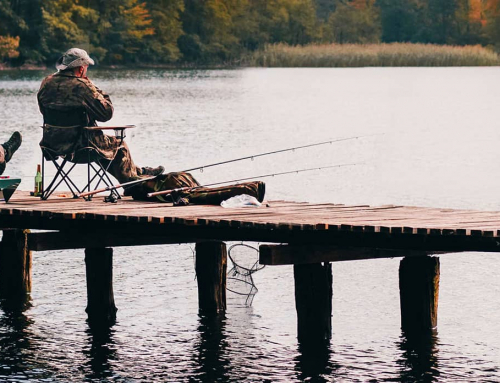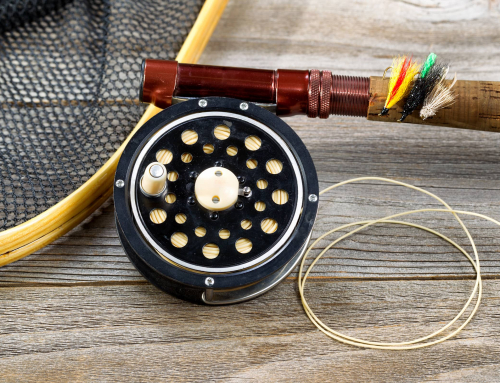We may earn money or products from the companies mentioned in this post at no additional cost to you.
What is the Best Fly Fishing Jacket?
A perfect day on the water starts with packing the perfect gear. While you can get away with low-quality gear in many different areas of fly fishing one thing you should never skimp on is a great jacket. A high-quality fishing or wading jacket makes a big difference between a cruddy day spent shivering and wet versus an enjoyable day even when it’s nasty out.
Only a couple decades ago fly-fishing jackets were dull and one-dimensional trash bags but today’s fly fishing jacket is be breathable, waterproof, windproof, and feels great all day no matter what you’re up against.

The advent of new jacket technology is great for anglers but leaves a lot to learn if you’re going to find the right match. Let’s review what you need to know about the best fly fishing jackets including materials, how to read ‘jacket language,’ and suggestions on great fly fishing jackets.
Fly Fishing Jacket Basics
Soft Shell Vs. Hard Shell
A big choice in fly fishing jackets is hard shell vs. soft shell.
Hard shell refers to tough, fully waterproof and windproof jackets while soft shell refers to more pliable, water-resistant and wind-resistant jackets.

Soft Shell Pros and Cons
Soft shells are meant to protect from moderate weather like cool temperatures and are only wind and water resistant though many are finished with a durable water resistant (DWR) coating. You can wear soft shells on their own or use them as an insulating layer under your hard shell. Soft shells are much lighter and more breathable than hard shells.
Hard Shell Pros and Cons
Hard shells are durable, windproof, waterproof, and generally what people think of when they imagine a rain jacket. Hard shells are meant to protect from direct elements but do not come with an insulating layer. Hard shells are less breathable and stiffer than soft shells.
Counting the Layers
When browsing hard shell jackets, you’ll notice that layers are mentioned. High-quality fly fishing jackets come in two, two and a half, and three layers. What’s do layers mean?
Two Layers – A two-layer jacket consists of a base material and waterproof membrane. Two-layer jackets aren’t the best at keeping water out during serious downpours, but their budget friendliness makes them a popular option if you don’t expect to get soaked.
Two and a Half Layers – Two and a half layer jackets are compromised of a base material, membrane, and a laminated or coated material that’s applied to the inside of the jacket. Because it’s normally sprayed on and extremely thin, the inner layer is only considered a half layer. Two and a half layer jackets are the most popular thanks to their combination of affordability, light weight, and ruggedness. For most fly fishers a two-and-a-half-layer jacket is a great match.
Three Layers – Do you plan on salmon fishing in Alaska? Do you want a jacket that can handle snow, ice, and wind? You need three layers. A three-layer jacks consists of a base material, waterproof membrane, and inner liner to protect the membrane. Three-layer jackets are the most rugged of all outdoor jackets, but those qualities come at a price. A high quality three-layer fly fishing jacket can cost anywhere from $125 to $500.
Jacket Features and Terms
Ripstop – Type of nylon construction where yarns are interwoven. Don’t over think it – ripstop will stop rips from becoming larger. Jackets made of ripstop fabric are more expensive but tough as nails.
Denier – Refers to weight of the jacket. Standard outdoor jacket denier measurements range from 30 to 150 denier. Higher deniers are thicker and more durable but less flexible and breathable.
DWR – Coating applied to jacket for additional waterproof capabilities.
Seams and Seals – Seams and seals can be sewn or directly applied. Sewn seams are normally stronger must be taped for protection. Look for “fully sealed” or “fully taped” zippers and seams over waterproof flaps.
Laminates or Coatings – Waterproof layers and other membranes can be laminated or sprayed (coated) onto the jacket. Laminated layers are higher quality (but more expensive) than coated layers.
Cut and Size – Be careful before ordering your fly fishing jacket. Outdoor jacket sizes can vary based on brand and cut which means you aren’t necessarily ordering the same size you wear in a shirt. Before choosing a size use a brand specific sizing guide to be sure your jacket will fit the right way. Keep in mind you might wear several layers below the jacket and will need extra room.
Fly Fishing Specific Qualities – Finally the jacket should have features that make fishing easier. Fly fishing specific features include pockets, clips, rings, linings, and other accessories that make your life easier on the water. Lower cost fishing jackets don’t normally feature extras but high-end jackets that are catered specifically to anglers do. Imagine a normal day on the water and if a jacket’s fishing specific features would help.
Fly Fishing Jackets and Breathability
Breathability is key to comfort. Do you remember putting on your waterproof jacket as a kid? Do you remember it felt like being trapped in a garbage bag filled with down? For several decades waterproof meant nothing could get in, but nothing could get out either.
That all changed in 1969, with the invention of Gore-Tex, the first waterproof and breathable material. What suddenly made jackets breathable? Tiny pores. New waterproof materials are filled with minute pores that allow moisture like water vapor to escape but block large drops from entering. Several other companies have now invented their own waterproof, breathable materials.
Breathability is not the same for every waterproof jacket and some are more breathable than others. If you’re looking for breathability ratings, you want to check the jacket’s Moisture Vapor Transmission Rate (MVTR.) The higher the MVTR, the more breathable the jacket is. Most MVTRs range from around 8000g to 30,000g.
NOTE: MVTR is normally only available for high-quality jackets. Don’t expect your local big box store to carry MVTR ratings on their discount rain jackets.
10 Best Fly Fishing Jackets
We’ve scoured shops and the web to find several great fly fishing jackets for a range of budgets. Check out these 10 best fly fishing jackets and why we like them.
Best Budget Friendly Fly-Fishing Jackets
There’s no need to shell out hundreds of bucks for your first fly fishing jacket, especially if you’re dipping your toes into the hobby. These 3 budget friendly options will give you a steppingstone to get on the water without racking your bottom line.
Compass 360 Ultrapak Ultra Lite Jacket ($35)
Need an easy rain jacket you can cram in your pack for emergencies? The Compass Ultrapak is your go-to. The Compass 360 Ultrapak is not the most rugged on our list and won’t last forever but the payoff comes in two ultra-light and ultra-breathable layers that will defend against pop up showers and wind. At under 40 bucks, the Compass 360 is a great deal.
Frogg Toggs Tekk Toad Wading Jacket ($50-$60)
Arguably the best fly fishing jacket for value on our list, the Tekk Toad is a great overall fishing jacket. The Tekk Toad is two and half layers of lightweight, breathable, and tough materials that feature fully taped seams to go along with the storm hood. The Tekk Toad comes with four chest pockets for quick access to equipment and tools while on the water.
Columbia Glennaker Lake Rain Jacket ($25-$75)
Most anglers don’t need a heavy duty and cumbersome raincoat and will be perfectly comfortable with an easy and lightweight jacket. The Glennaker Lake from Columbia is the perfect “toss into the bag” raincoat that’s still waterproof. The Glennaker is not the most breathable of our jacket list but is among the best value. Columbia also produces an insulated version for extra warmth.
Best Budget Friendly Fly-Fishing Jackets
Fly fishing jackets are all about getting the most out of your dollar. If you’re ready for a ‘full time’ fishing jacket with a great bang for your buck value, check out these 3 fly fishing jackets.
Caddis Wader Jacket ($50 – $110)
Caddis has produced great wading gear for years and they come through again in the breathable wading jacket. There aren’t many fishing frills on the wader jacket, but wearers can enjoy two chest rings, waterproof chest pockets, and comfortable fleece collar. The wader jacket is made for easy attachment to Caddis wading systems.
Frogg Toggs Cascades ($90)
The Cascades is the upgraded version of the Tekk Toad with more than 18 pockets in and outside of the jacket to hold an entire day’s worth of supplies. All seams are sealed in this rugged 3-layer coat that’s made to handle nasty rain and wind. With large storm hood and adjustable cuffs and waistband you can stay on the water no matter what the weather’s doing.
Simms Rogue Fleece Hoody ($95)
If you want Simms quality but fish in more temperate environments check out the Rogue Fleece Hoody. The Rogue is tough enough for the water, but fashionable enough to wear around town and coats you in a warm fleece lining. There are much cheaper soft shells but Simms makes a product that lasts.
Top End Fly Fishing Jackets
Are you crushing fish every weekend? Do you camp out at your favorite spot for days at a time? If you’re ready to take your fly-fishing gear to the next level check out these high quality fishing jackets.
The North Face Apex Bionic 2 ($80-260)
Our favorite softshell on the list. The North Face Apex is a fantastic all-around softshell for outdoor uses including fly fishing. Though it’s not fully waterproof, the Apex is constructed with a windbreaking layer and DWR finish for water resistance. North Face’s high-quality materials make the jacket comfortable, warm, and tough against the elements for a softshell.
Simms Challenger Jacket ($180-$250)
Simms is a well-known name in fly fishing for their high-quality goods. That quality continues in the Challenger raincoat. The Challenger is made for rugged fishing and extreme environments with heavy duty proprietary technology, fully taped seams and seals, and fleece-lined front pockets. The Challenger is by far our toughest two-layer jacket on the list.
Orvis Ultralight Wading Jacket ($150-$250)
Orvis’s ultralight wading jacket has become one of the most popular fishing jackets on the market. This jacket is ultralight, ultra-breathable, and constructed of 3 layers of Orvis technology. You can wear the Orvis lightweight by itself during summer rainstorms or as your first layer in rougher weather. If you’re a frequent fisher or hike to your fishing spots, an ultralight jacket is always a great idea.
Carhartt Shoreline ($120-145)
Carhartt is a legendary name in ruggedness and those qualities show through in the Shoreline hard / softshell. Designed for on the water use, the Shoreline is manufactured in a hard-shell version, soft shell, insulated hard shell, bibs, and wading pants. You can wear Shoreline from head to toe for a wonderfully comfortable day on the water.
Finding the Perfect Fly-Fishing Jacket
Thanks to new materials and techniques there are more fly-fishing jackets and features than ever before, making choosing the right jacket tough. Consider your budget, needs, the above factors and what type of elements you normally encounter to help you choose. Ultimately the perfect fly fishing jacket is the one that helps you best enjoy a great day fishing.





